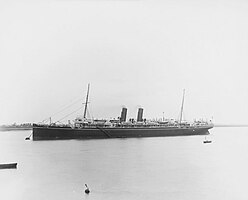Arabia (ship)
|
||||||||||||||||||||
|
||||||||||||||||||||
|
||||||||||||||||||||
|
||||||||||||||||||||
|
||||||||||||||||||||
The Arabia was a passenger ship put into service in 1898 by the British shipping company Peninsular and Oriental Steam Navigation Company (P&O), which carried passengers, freight and mail from England to India and later to Australia . She was the last ship of her shipping company with only one screw. The Arabia was torpedoed and sunk in the Mediterranean by the German submarine UB 43 without warning in 1916 , killing eleven people.
construction
The Arabia was the fourth in a quintet of sister ships that P&O commissioned for its passenger and freight traffic to Asia. The others were China (1896), India (1896), Egypt (1896) and Persia (1900). With these large, modern ships, P&O was able to maintain a regular liner service between England and the British colonies in Asia. The Arabia and her sister ships were the largest and most modern steamers in the P&O fleet to date.
The 7,903 GRT steamship was 152.3 meters long, 16.6 meters wide and had a maximum draft of 7.5 meters. The Caird & Company triple expansion steam engines produced 11,000 PSi . The top speed was 18 knots. On board there was space for 320 passengers in the first class and 160 passengers in the second class. On March 12, 1898, the Arabia was completed.
The then very popular London designer, painter and interior decorator William De Morgan was responsible for furnishing the passenger accommodation. For example, he designed decorative panels for the lounges that showed the destinations of the ships. The ship served the route London - Bombay with various stops in the Mediterranean area such as Port Said or Malta .
history
The Arabia was launched on November 10, 1897. Due to a strike by the shipyard workers, the originally planned date had not been met. On March 12, 1898, the ship was registered in London. It had cost 250,000 pounds sterling to build . In the spring of 1898, the ship set out on its maiden voyage to India. The Arabia stayed on this route until the outbreak of the First World War .
In 1899 the Arabia brought the politician George Curzon, 1st Marquess Curzon of Kedleston to India for his coronation as Viceroy of India . In the summer of 1902 she transported a large group of passengers to Delhi for the coronation celebrations of King Edward VII , who was crowned Emperor of India on August 9, 1902 .
Accidents occurred repeatedly during the service life of the ocean liner: in 1905 it collided with the Riverdale in the port of Bombay . A similar incident occurred in 1912 when he collided with the Powerful off Southampton . In early 1915 the Arabia was moved to the England – Australia route. On May 9th of the same year, she escaped an emerging submarine in the English Channel by putting a curtain of smoke around her. On July 3, she again fled two submarines in the English Channel.
Sinking
On Saturday, September 30, 1916, the Arabia cast off under the command of Captain WB Palmer in Sydney with 437 passengers and 283 crew members for the return journey to England. The first stop was Fremantle on the west coast of Australia . Then the ship ran into the Indian Ocean , steamed through the Red Sea and finally reached the Mediterranean.
On Monday, November 6, 1916 around 11 a.m., the German submarine UB 43 under the command of Kapitänleutnant Hans-Joachim von Mellenthin, 112 miles southwest of Cape Tenaro on the south coast of Greece , sighted the steaming ship westward, which was still about 300 Headed for Malta miles away. Von Mellenthin gave the order to fire without warning. The explosion of the torpedo in the engine room killed eleven machinists there. Within 15 minutes everyone else on board had left the sinking steamer. The Arabia sank 20 minutes after the attack .
Most of the survivors were picked up by the City of Marseilles passenger ship and taken to Port Said (Egypt). Four armed tugs also took part in the rescue and brought the passengers they had rescued to Malta. The fact that the Germans had sunk a ship that had 187 Australians on board led to an increase in voluntary reports for military service in Australia.
Of the 23 ships that UB 43 sank, the Arabia was the largest. Her sister ships India (160 dead) and Persia (343 dead) were also sunk by German submarines during World War I.
Web links
- Technical and historical data in the Clydebuilt Ships Database (with picture)
- Technical and historical data from a list of P&O steamers (PDF file; 85 kB)
- Passenger steamer Arabia - Ships hit by U-boats - U-boat War in WWI - uboat.net The Arabia in the U-boat database
- Report of the sinking from The Argus newspaper on November 9, 1916
Related topics
The passenger ships Laconia , Hesperian , Leinster , Falaba , Medina , Maloja , Apapa , Missanabie , Ancona and many others were also sunk by German submarines during the First World War .
